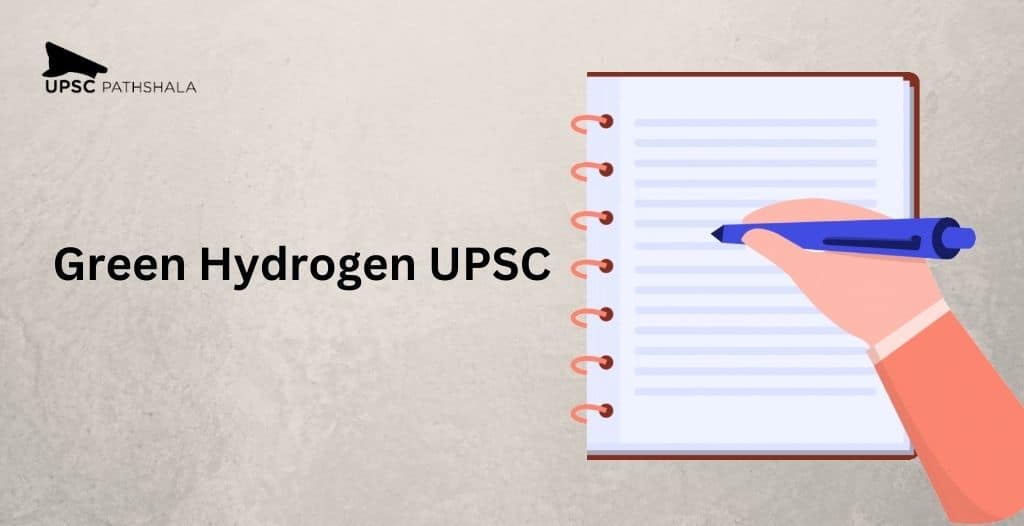Green hydrogen is considered one of the most promising solutions for reducing carbon emissions in the future. The production of green hydrogen relies on renewable energy sources such as solar and wind power, which are used to split water molecules into hydrogen and oxygen. Green hydrogen is considered a zero-emission fuel that can be used in various sectors such as transportation, industry, and power generation.
Green Hydrogen Mission in Relevance to UPSC
The Union Government of India has launched the National Green Hydrogen mission to accelerate the development and deployment of green hydrogen in the country. This mission is highly relevant to the UPSC exam, as it is an essential topic for the Science and Technology, Environment, and Energy sections of the exam.
National Green Hydrogen Mission UPSC Notes
The National Green Hydrogen Mission aims to achieve the following objectives:
- To promote the production and use of green hydrogen in India.
- To develop a green hydrogen ecosystem, including R&D, manufacturing, storage, and transport.
- To reduce the cost of green hydrogen production and increase its competitiveness with conventional fuels.
- To create a market for green hydrogen in various sectors such as transportation, industry, and power generation.
- To support the growth of green hydrogen technology start-ups and encourage private sector participation.
- To establish a regulatory framework for the production, storage, transport, and use of green hydrogen.
Important Facts on Green Hydrogen Mission
- The National Green Hydrogen Mission was launched in August 2021.
- The mission has a target of producing 1 kg of green hydrogen at a cost of Rs 100 by 2023, which is expected to decrease to Rs 60 by 2030.
- The mission aims to achieve a green hydrogen production capacity of 1 GW by 2022, which is expected to increase to 10 GW by 2030.
- The mission aims to create a green hydrogen ecosystem, including R&D, manufacturing, storage, and transport.
- The mission is expected to create jobs in the green hydrogen sector, which is estimated to grow to 2 million by 2050.
- The National Green Hydrogen Mission has been launched under the Ministry of New and Renewable Energy (MNRE) and is a part of the larger National Hydrogen Energy Mission.
- The mission aims to achieve a target of 10% blending of green hydrogen with compressed natural gas (CNG) by 2030.
- The government has set up a high-level steering committee and a technical committee to oversee the implementation of the National Green Hydrogen Mission.
- The mission has received funding from various sources, including the National Clean Energy Fund, the Clean Energy Fund, and the World Bank.
- The government has also announced various incentives such as subsidies and tax exemptions to encourage private sector participation in the green hydrogen sector.
- The mission is expected to play a crucial role in achieving India’s climate change goals under the Paris Agreement.
- The mission aims to reduce India’s dependence on fossil fuels and increase its energy security by promoting the use of green hydrogen.
- The government has also launched the Green Hydrogen Auction Scheme, which aims to provide a platform for the sale and purchase of green hydrogen.
- The mission is expected to create a significant demand for renewable energy sources such as solar and wind power, which are used to produce green hydrogen. This, in turn, is expected to drive the growth of the renewable energy sector in India.
- The government has also announced the establishment of a Green Hydrogen Fund, which will provide financial support for the development and deployment of green hydrogen projects in the country.
- The mission is expected to promote research and development in the green hydrogen sector and encourage the adoption of new technologies.
- The mission is also expected to have significant implications for the automobile sector, as green hydrogen can be used to power fuel cell vehicles.
- The mission is expected to promote the growth of green hydrogen technology start-ups and create a favourable environment for innovation and entrepreneurship in the sector.
- The mission is expected to have a significant impact on the global energy landscape and position India as a leader in the green hydrogen sector.
How to Prepare for Such Topics?
To prepare for topics related to green hydrogen, candidates should focus on the following:
- Understanding the basics of hydrogen, its production methods, and its various applications.
- Understanding the difference between green hydrogen, blue hydrogen, and grey hydrogen.
- Knowledge of renewable energy sources such as solar and wind power, which are used to produce green hydrogen.
- Understanding the various applications of green hydrogen in sectors such as transportation, industry, and power generation.
- Understanding the National Green Hydrogen Mission and its objectives.
- Knowledge of various initiatives taken by the government to promote green hydrogen in India.
Conclusion
The National Green Hydrogen Mission is a significant initiative taken by the government to promote the production and use of green hydrogen in India. Candidates appearing for the UPSC examination should focus on this topic, as it is highly relevant to the Science and Technology, Environment, and Energy sections of the exam. Understanding the basics of hydrogen, its production methods, and its various applications is crucial for cracking the UPSC exam.







